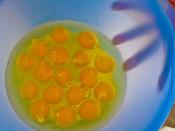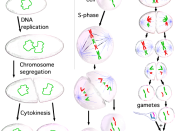Cell Division- Mitosis
As a cell grows, more demand is placed on exchange of materials (nutrients intake, waste removal intake). Also more demands are placed on its DNA
As a cell grows it's surface area grows slower (Pie R Squared) than its volume (Pie R Cubed). When the ratio of Surface Area/Volume reaches a specific point chemicals called cyclins begin the cell division process.
What are chromosomes?
They are a protein structure that contain DNA (genetic information)
Humans have 23 pairs of chromosomes or 46 in EVERY cell. In other words each cell had the complete library of information. (Fruit flies have 4 pairs of chromosomes or 8 chromosomes)
Chromosomes cannot be seen in a cell's nucleus until the cell duplicates all the chromosomes just before mitosis (cell division).
When the DNA and chromosomes have doubled, each chromosome has an identical pair. We call these pair's chromatid pairs.
They are held together by a small microtube called a centromere.
Two Identical Chromatid held by a centromere (dot)
Cell Cycle
All cells go through a cycle. The longest part is interphase, a gap (G1) in time where the cell grows and functions but does not reproduce.
Next comes the "S" phase. In this phase DNA is replicated and Chromosomes duplicated in Chromosome pairs. After this comes a short "G2" phase where molecules and organelles that cause Mitosis are produced. The last phase is "M" or Mitosis phase.
Mitosis has four steps:
A. Prophase B. Metaphase C. Anaphase D. Telephase the cell seperates into two new cells. In animal cells it completely seperates, this is called cytokinesos.


